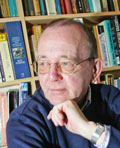I'm still wrestling with writing—the book on teaching, that is—and it is all the harder now that the academic year has finished, and I don't have the fuel of current practice to direct my attention. So I have turned back to some classics (at least in my assessment) to re-stimulate my thinking, and I thought I'd share some of my thoughts..
Richardson, E (1967) The Environment of Learning; conflict and understanding in the secondary school London; Heinemann Education (1973 edn.)
WorldCat.org lists 17 editions, including e-editions. I bought it used through Amazon for one penny (+ £2.80 postage, several other copies still available).
I nearly worked for Elizabeth Richardson. In the mid-1970s she was at the University of Bristol and looking for a research fellow for one of her projects, and I applied. I was able to claim a shared background; she had been heavily influenced by the (mildly Kleinian—Melanie, not Josephine) work on group relations which gave rise to the Tavistock Institute/Leicester University experiential (a.k.a. "working") conferences from the early '60s on. I had worked for the Grubb Institute—a sort of junior partner in the enterprise—and participated in several similar events. (They are still going—the 2014 event is the 68th, and takes place in August, and spin-offs are international.)
I went to Bristol for a very pleasant and stimulating interview, but learned that her research had moved on to work on local authorities' management of schools (they did a lot more of that in those days) rather than concentrating on the eco-system of the classroom, as I might now describe her focus. It's much easier to find the labels for her perspective now than it was then, which must say something about how much systems perspectives have permeated our thinking.
But that must lead to an initial observation; the language (and more important, the perspectives it embodies) are dated. There are of course references to grammar- and secondary-modern schools, and leaving school at 15 (so-called ROSLA did not come in until 1974, if I remember rightly), but that's just historical. It's the unselfconscious references to "bright" and "backward", and "coloured" pupils (not "students") which leap out, including this gem, "these were 15-year-old girls of pathetically low ability" (p. 147). It's the assumptions about streaming. And, most germane for a current reading, it's the default assumptions about the authority of and respect for the teacher.
And of course that is one of the key elements of this book. Because, regardless of the default assumption, no-one I have read since has so clear-sightedly and non-judgementally sought to uncover and explore what goes on beneath the surface of the classroom (and the school). I mentioned an "eco-system" earlier; Richardson approaches the class as an ecologist might approach a rainforest.
Much of the first half of the book is about what would nowadays be called "behaviour management". Much as I respect people like Sue Cowley and Tom Bennett, their approach is—although in many respects consistent with Richardson's (given that she doesn't do prescription)—simply pragmatic. It's about ground-rules and fire-fighting. And it works. 'Nuff said.
Except that Richardson does not stop there; enough has not been said. From a group relations perspective, she regards almost everything which happens (and some things which don't happen) at several levels. Class behaviour has to be managed, certainly, but it is also evidence of the underlying emotional life of the group, both that which can be expressed and that which must be denied. And the teacher is part of this process, not an objective outsider, but as exposed as anyone else. Indeed, the issue of how the teacher's anxiety can motivate problematic practice and inhibit good practice (especially holding back and doing nothing) is a recurrent theme.
It's a fascinating "lens" to use Brookfield's term, or frame of reference. It highlights (or "privileges" in the current jargon) a neglected aspect of the environment of learning, including the implications of the physical layout of classrooms (rather less of an issue now, I think. For my take see here and here) and time tabling.
By current standards, the argument is loose and merely assertive. Only in the boring chapters 7 and 8 is the referencing anywhere near current standards (and it's not "Harvard"!)
The originality dips from chapter 7 onwards and slowly climbs to the conclusion. Skim.
So? This is largely based on secondary education in the '60s, which was a different world in some respects, but still recognisable in those areas with which this book concerns itself. It may appear that the current competitive, high-stakes testing setting has invalidated the arguments and the admittedly anecdotal evidence base. In some respects they have. There are no effect-sizes from meta-analyses to support them. Some of the practice described in chapters 7 and 8 nowadays prompts responses such as, "Yes, but—what were they learning?" But they are not simply examples of the much-derided pupil-centred approaches of the '60s; there is a degree of rigour here, and interesting explorations of how rules and rituals structure the pupil experience to provide the security needed to tolerate the uncertainty of venturing into unknown territory.
It has to be said that translating all this to the world of post-compulsory education is not straightforward; Richardson is good on the how the default structures of primary schools and secondary schools (a single teacher working with a class on practically all subjects in the former case, and subject specialists taking classes only for their subjects in the latter) affect the role of the teacher and the dynamics of the class, but the school is still a stronger, more containing institution than the FE college or the university. The social and emotional ties (and splits) are looser in the college, but they are still influential, particularly on professional courses where a cohort of students work with a fairly small team of lecturers consistently over from one to four years.
Even so. There's a lot to learn. But sadly it can't be communicated in a half-day CPD session and that in itself may disqualify it... And no, it's not the same as "Emotional Intelligence". But the book is as good as it gets as an introduction, and if you are looking for a trajectory for professional development over a decade or a career, this could be it. It will certainly maintain your fascination with teaching.
26 July 2014
Subscribe to:
Post Comments (Atom)



No comments:
Post a Comment
Comments welcome, but I am afraid I have had to turn moderation back on, because of inappropriate use. Even so, I shall process them as soon as I can.